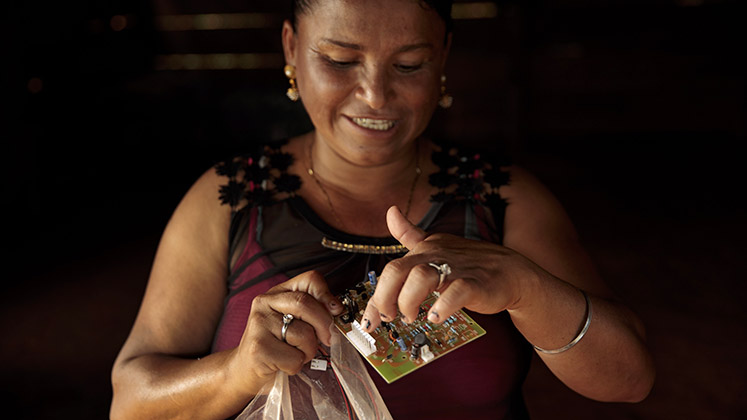 Real and credible development in these countries means pursuing knowledge social economy visions that are genuinely autochthonous, writes Valbona Muzaka (King’s College London).
Real and credible development in these countries means pursuing knowledge social economy visions that are genuinely autochthonous, writes Valbona Muzaka (King’s College London).
Focusing on Brazil and India in the context of renewed discussion of the developmental state may raise some eyebrows. For, unlike the successful catch-up of Japan and other East Asian ‘tigers’ with which that concept and its more recent reiterations have been associated, neither the Indian nor the Brazilian state has ever managed fully to secure its developmentalist credentials, especially when the outcomes of their strategies are compared with those of the Asian ‘miracle’.

Using the successful East Asian state form as the yardstick for the application of the developmental state concept everywhere would, however, only betray the extent to which our collective grasp of political economy has been limited and ahistoricised: as the painstaking work undertaken by Eric Reinert and colleagues at the Other Canon suggests, the central role that states in their various forms (city-republican, mercantilist, imperial and so on) have played in orchestrating technological, economic and social development for the last 500 years, if not before, is well-known.
During this period, the developmental state has always been one that designs and orchestrates socio-economic-political strategies aimed at catching up with whatever it deems an advanced economy at a given point in time. The developmental state is, like all states, spatially Janus-faced – looking both inwards and outwards and anchored simultaneously in the national and the global terrain. What is more, it must not only pursue catch-up in the shadow of advanced economies, but also in competition with other states vying for the same in an unequal world market whose dynamics, to make things worse, are always changing, thus requiring novel and ever more complex strategies to succeed.
The purpose of reconstructing the concept of the developmental state in these terms is not somehow to restore the developmentalist credentials of the Indian and Brazilian states, but rather to locate their developmental strategies in the historical ‘catch-up treadmill’ and, in so far as it makes clear that the developmental state is perpetually pursuing a moving target on uneven global terrain, to pose the question of what possibilities and obstacles the current juncture presents them. In particular, I point to one critical challenge that no other developmental state in the last 500 years has had to face, which is catching up in the face of de-industrialisation.
What have the Indian and Brazilian states done towards dealing with this challenge so far? The answer is very little, certainly when de-industrialisation initially reached their shores. Although by 1980 their respective strategies had succeeded in creating a significant industrial base – around 44% and 24% of total GDP in Brazil and India respectively – the application of technology and the resulting degree of competitiveness varied greatly within and between them, with high-tech sectors constituted largely of ‘pockets of excellence’ – in atomic research, space technology, and defence in India and aeronautics, agricultural research, and petrochemicals in Brazil. The reality was that industrialisation had not yet succeeded in creating a cohesive domestic productive structure. Their industrial bases were hardly ‘mature’ or ‘ripe’ for de-industrialisation of the kind that was visited on them. This was substantial: the share of employment engaged in manufacturing in Brazil peaked in the 1980s at 15% of total employment, whereas in India it peaked later in 2002 but at the even lower rate of 13%.
Not only did the state in both countries do little to stem de-industrialisation; it also contributed to it by its own embrace of a new developmental/catch-up dynamic, one based on ‘competitive insertion’ into global markets whose dynamics were being reformulated along neoliberal lines from the 1980s onwards. As Brazil and India opened up their economies – more cautiously, but still decisively, in India’s case – and deepened their integration with advanced economies with greater economic and technological sophistication, their most advanced industrial sectors were the first casualties.
Consequently, India and Brazil can be said to have ‘imported’ de-industrialisation from advanced economies, something that was not entirely forced on them. Many factors undoubtedly contributed to the adoption of this new catch-up strategy, but the important role played by the re-orientation of the Indian and the Brazilian states should not be underestimated. It was key fragments within each state that decided to respond to the changes in the world economy during the late 1980s by trying to become competitive knowledge powers along the lines around which the United States – the advanced economy then casting the longest shadow on developmental states everywhere – had redefined itself. This orientation survived changes in governments of different political character in both countries from the late 1980s onwards: India’s aim of becoming one of the top five global knowledge powerhouses is now officially a state project, as is Brazil’s goal of becoming the technological and environmental power of the 21st century.

The adoption of a raft of institutional reforms in pursuit of these goals in areas such as FDI, banking and capital flow rules, the macro-economy, and intellectual property resulted in the further weakening of the domestic productive structure, whose ‘pockets of excellence’ could not generate the necessary capabilities to operate close to the technological frontier, a key prerequisite for becoming a knowledge/learning economy today. In practice, the gap has been filled by services and commodities in the case of Brazil and services and informal manufacturing in the case of India. Although these sectors are not condemned to be technologically unsophisticated delivering low value-added, they may remain so unless unorthodox institutional reforms are undertaken.
I use ‘unorthodox’ intentionally here. Precisely because development implies pursuing a moving target on uneven global terrain, it cannot be achieved merely by following the lead of advanced economies. It requires experimenting with unorthodox, imaginative and innovative strategies and, just as importantly given the serious problems affecting the so-called developed economies today, conceiving of novel visions of development altogether. While there remain obvious limits to the room for manoeuvre of all states, the continental size of these two economies – India’s more so than Brazil’s – offers them options not available to smaller developing countries.
What can India and Brazil do over the next decades? If industrialisation as a catch-up strategy is closed in the immediate future, this has less to do with technological change than the financialisation of the world economy into which they are now (differently) integrated; certainly, it has little to do with their industrial bases exhausting their potential. Finding a way to ‘reign finance in’ would help, as would establishing ‘smart’ production-based sectors that are research-intensive and aimed at overhauling production and consumption patterns in ways that favour quality, durability, low energy, recyclability, waste management and so on.
The ongoing enclosure of knowledge in private hands, largely as a result of institutional reforms undertaken in imitation of similar developments in the US and other advanced economies, requires immediate attention. If services or commodities are to be the future engine of growth for these two countries and are to become knowledge-intensive, unorthodox policies are needed to replenish the knowledge commons and reverse the ‘tragedy of the anti-commons’ whereby accumulated intangible assets bloat the market evaluation of large firms and attract financial speculation, but severely limit real investment opportunities and the diffusion of knowledge into society.
The key step that needs to be taken is the abandonment of the perception that the developed countries hold the key to the only real and credible mode of development. In concrete terms, this would mean a shift from attempting to become competitive knowledge economies in the US mould towards advancing knowledge social economy visions that are autochthonous to India and Brazil themselves. Their continental scale and the long list of social needs for large parts of their population – e.g. decent housing, education and healthcare, food security, good work opportunities and working conditions, adequate social protection – make such visions possible.
But knowledge social economies that make meeting these needs simultaneously the means and the end of development necessitates at the very least a range of institutional innovations: that counter the tendency of market players’ technological efforts to focus short-term returns regardless of social or environmental; that direct finance towards job-creation in ‘smart’ productive processes and services; that stimulate much wider access to knowledge and considerable investment in upgrading the competencies of low-skilled workers; that enhance trust and respect for the independence of non-economic forms; and that promote collective solutions and distributional policies that share economic dividends widely.
It’s a big proviso, admittedly, but, if they are willing to experiment in pursuit of such social visions, the Indian and Brazilian states can still take advantage of existing windows of opportunity to reach the ‘developed’ status that has eluded them – and others – so far.
Notes:
• The views expressed here are of the authors rather than the Centre or the LSE
• This post was first published by SPERI as part of a series on the developmental state
• Please read our Comments Policy before commenting





